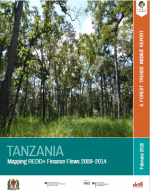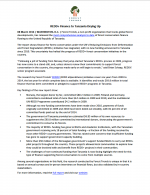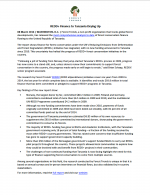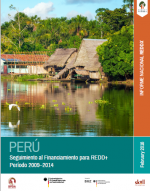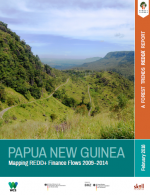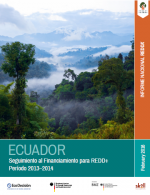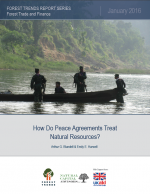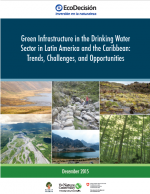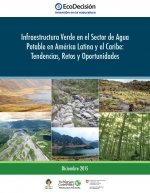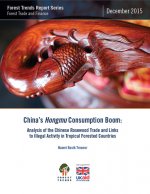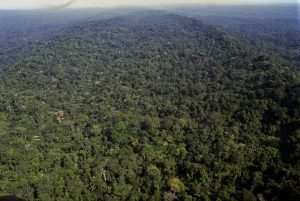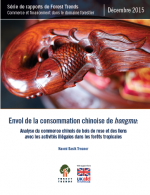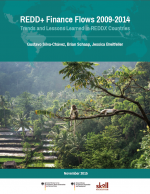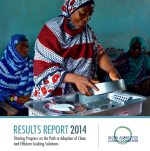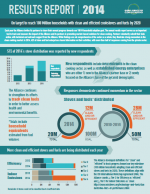Building Carbon in America’s Farms, Forests, and Grasslands
Foundations for a Policy Roadmap
By Emily McGlynn, Christopher Galik, David Tepper, Jerod Myers, Julie DeMeester - Forest Trends, Forest TrendsForest Trends and the Nicholas Institute at Duke University have authored a new report, “Building Carbon in America’s Farms, Forests, and Grasslands: Foundations for a Policy Roadmap.” This innovative assessment offers new analysis to support a long-term roadmap for enhancing the U.S. land carbon sink, ensuring healthy and productive landscapes contribute to greenhouse gas reduction […]
Tanzania: Mapping REDD+ Finance Flows 2009-2014
By Erneus Kaijage, George Kafumu - Forest Trends, United Republic of TanzaniaThis report presents the findings of the second and third rounds of REDD+ finance tracking in Tanzania for the period 2009–2014 under the Forest Trends REDDX initiative. The first and second rounds of REDD+ finance tracking were conducted for the period of 2009–2012 and 2009–2013; this report updates and extends those findings through 2014. Overall, […]
Perú: Seguimiento al Financiamiento para REDD+ Período 2009–2014
En el Perú, existen varios proyectos e iniciativas relacionados con el mecanismo de reducción de emisiones por deforestación y degradación forestal (REDD+). La iniciativa REDDX de Forest Trends logró identificar a varias organizaciones de la sociedad civil y empresas que han estado implementando actividades relacionadas con REDD+, para las cuales han recibido financiamiento de donantes […]
Email Signup
Subscribe to any of Forest Trends’ mailing lists to keep up with the news, publications, and events that interest you.
Having Trouble?
If you experience any technical difficulties on our site, please contact Genevieve Bennett, Communications Manager.
Papua New Guinea – Mapping REDD+ Finance Flows 2009-2014
By Benzolo Ken, Ezra Neale - Wildlife Conservation Society - Papua New Guinea, Wildlife Conservation Society - Papua New GuineaThis report presents the findings from the first round of REDD+ finance tracking in Papua New Guinea (PNG) under the REDDX initiative through Forest Trends. The REDDX initiative is the first comprehensive attempt to track and report on financial commitments and disbursements for REDD+ activities in PNG. REDDX was conducted in PNG through a partnership […]
Ecuador: Seguimiento al Financiamiento para REDD+ Período 2013–2014
Como parte del proyecto internacional de Seguimiento al Financiamiento para REDD (REDDX), Forest Trends y EcoDecisión desde el año 2012 han recopilado información sobre los flujos financieros para las actividades REDD+ en Ecuador. Basado en estudios detallados y entrevistas con las principales partes interesadas incluidos financiadores, organizaciones responsables de implementación, beneficiarios y agencias gubernamentales, REDDX […]
How Do Peace Agreements Treat Natural Resources?
By Arthur Blundell, Emily HarwellOf the 800 peace agreements signed around the globe since 1945, fewer than 15 percent address natural resources — even though those resources (oil, gas, timber, diamonds) increasingly are recognized as a major factor in armed conflicts, according to a new study by the non-profit organization Forest Trends. The failure to reform management of these […]
Green Infrastructure in the Drinking Water Sector in Latin America and the Caribbean
Trends, Challenges, and Opportunities
By Marta Echavarria, Paola Zavala, Lorena Coronel, Tamara Montalvo, Luz Maria AguirreThe study was designed to document the state of initiatives and investment in green infrastructure by water regulators, drinking water operators, and project developers in Latin American and Caribbean countries, It includes activities such as: payment for ecosystem services projects, water funds, promotion of investment plans for climate change adaptation in watersheds, recuperation of vegetative […]
Dependent Documents
Infraestructura Verde en el Sector de Agua Potable en América Latina y el Caribe
Tendencias, Retos y Oportunidades
Infraestrutura Verde no Setor de Água Potável na América Latina e Caribe
By Marta Echavarria, Paola Zavala, Lorena Coronel, Tamara Montalvo, Luz Maria AguirreChina’s Hongmu Consumption Boom
Analysis of the Chinese Rosewood Trade and Links to Illegal Activity in Tropical Forested Countries
By Naomi Basik Treanor - Forest TrendsChina’s demand for rosewood – used for classical Chinesestyle furniture and décor – is threatening some of the world’s most valuable and endangered old-growth forests. Chinese furniture manufacturers’ imports of several species of rosewood, collectively known as hongmu, have soared at an unprecedented rate since 2010 and hit an all-time high in 2014, according to […]
Dependent Documents
Chinese Demand for Illegal Rosewood Drives Tropical Forest Destruction in Asia, Africa
Classical furniture boom presents urgent challenges for legal, sustainable sourcing
Envol de la consommation chinoise de hongmu
By Naomi Basik Treanor - Forest Trends中国的红木消费热潮 (China’s Hongmu Consumption Boom)
中国红木贸易及其与热带国家非法森林活动关系之分析 (Analysis of the Chinese Rosewood Trade and Links to Illegal Activity in Tropical Forested Countries)
By Naomi Treanor- Forest TrendsREDD+ Finance Flows 2009-2014
Trends and Lessons Learned in REDDX Countries
By Gustavo Silva-Chávez, Brian Schaap, Jessica BreitfellerForest Trends, a non-profit organization that tracks global forest developments, today released the most comprehensive analysis to date of the United Nations’ program for protecting forests and generating forest conservation finance. The study follows the money trail in 13 countries that account for 65 percent of the globe’s tropical forest cover under the U.N.’s Reducing […]
Results Report 2014
Sharing Progress on the Path to Adoption of Clean and Efficient Cooking Solutions
By Global Alliance for Clean Cookstoves, Ecosystem MarketplaceThis report provides a snapshot of how the partners of the Global Alliance of Clean Cookstoves are progressing in its strategic vision of facilitating the adoption of 100 million cookstoves by 2020 as reported by our partners. Two important features of the 2014 results report are: This year’s report integrates information from the Alliance’s Clean […]

